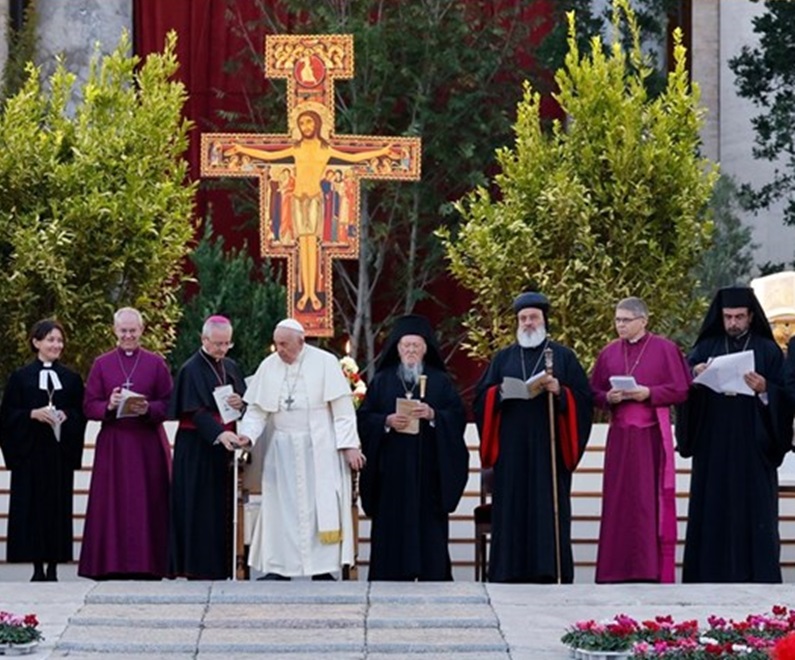Ecumenism: The primacy of Peter in the 21st century
From the Dicastery for the Promotion of Christian Unity a "study document" summarising the responses received from the other Christian confessions to the invitation launched 30 years ago by John Paul II to take up the ministry of the Bishop of Rome together. Among the hypotheses also the idea of a "synodality ad extra" with periodic meetings between the leaders of the different Churches.
Vatican City (AsiaNews) - The primacy of Peter is no longer an obstacle but an opportunity for unity among Christians. Beginning with that redeclension that is already underway in the Church of Rome through the relaunching of the dimension of synodality and the "new climate" that for years now has been breathed in relations between the leaders of the Christian confessions.
This is a glance summary of the perspective presented in the study document "The Bishop of Rome. Primacy and synodality in ecumenical dialogues and in the responses to the encyclical Ut unum sint', approved by Pope Francis and presented today at the Vatican by the Dicastery for the Promotion of Christian Unity.
A long and articulated text that for the first time summarises the contents of the ecumenical confrontation opened almost thirty years ago by John Paul II, who in 1995 in the encyclical letter Ut unum sint had hoped that Christians could find together the most appropriate forms so that the ministry of the bishop of Rome "may realise a service of love recognised by one another".
That appeal has received around 30 responses from other Christian denominations in recent years, as well as 50 ecumenical dialogue documents on the subject, on which Pope Francis has invited the dicastery to continue working.
The result is this summary that lists the results of the theological confrontation, but also "some practical suggestions" for moving forward towards what is called "a ministry of unity in a reconciled Church".
The document emphasises how practically all the texts received today agree on the need for a service of unity on a universal level, even if there are different opinions on the foundations and ways of living it out.
"Referring to the apostolic tradition, some dialogues maintain that, from the very origins of the Church, Christianity was founded on principal apostolic sees that occupied a specific order, of which the see of Rome was the first".
In this sense - therefore - in the ecumenical world the question of primacy is no longer seen simply as a problem, but as an opportunity for reflection on the nature of the Church and its mission in the world. In theological reflection itself, there is more attention to what Scripture says about Peter's role among the apostles, rather than to doctrinal developments and the wounds of history; and this allows for "challenging some traditional confessional interpretations".
This does not mean, of course, that all obstacles are overcome: many Christian denominations, for example, ask the Catholic Church for a 'reformulation' of the teachings of the First Vatican Council, with its definition of universal jurisdiction from the pope and the dogma of infallibility.
The intention is to distinguish between what was linked to the historical context in which they were proclaimed and what remains relevant today, in the light of the ecclesiology of communion later affirmed by the Second Vatican Council and the current cultural and ecumenical context. Just as - especially in the world of Eastern Christians - the condemnation of Uniatism remains firm: it is not the Eastern Rite Catholic Churches, they argue, the model around which to rethink unity in diversity.
Instead, the path indicated for Christian unity in the 21st century passes through "a mutual interdependence between primacy and synodality at every level of the Church". From a theological point of view, the document defines it as "an articulation between 'all', 'some' and 'one'" as three complementary spheres.
It evokes "the community dimension, based on the sensus fidei of all the baptised, the collegial dimension, expressed above all in episcopal collegiality, and the personal dimension expressed by the primatial function". But these are articulations that do not only affect the relationship between the successor of Peter and the different ecclesial communities in the world, but they arise as in a dynamism at every level.
For example, there is much insistence also from ecumenical interlocutors on the enhancement of national and regional Catholic bishops' conferences. In a Church that recognises the principle of subsidiarity: 'No issue that can be adequately dealt with at a lower level should be taken to a higher one'.
In this sense, some voices insist that 'the power of the bishop of Rome should not exceed what is necessary for the exercise of his ministry of unity at the universal level', while recognising the need for 'a sufficient degree of authority to deal with the many challenges and complex obligations associated with his ministry'.
Finally, it is hoped that there will also be a growth in synodality ad extra, with periodic opportunities for meetings between the leaders of the Christian denominations. Much has already been done in this sense in recent decades, including with the initiatives and apostolic trips that Pope Francis has promoted together with patriarchs of the East and Anglican and Protestant leaders. But the document also hypothesises the idea of "regular consultations" to "make visible and deepen the communion they already share".







.png)










